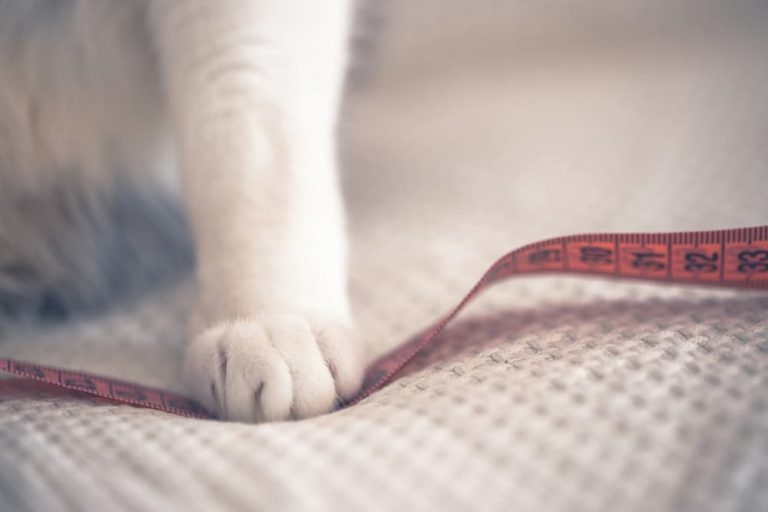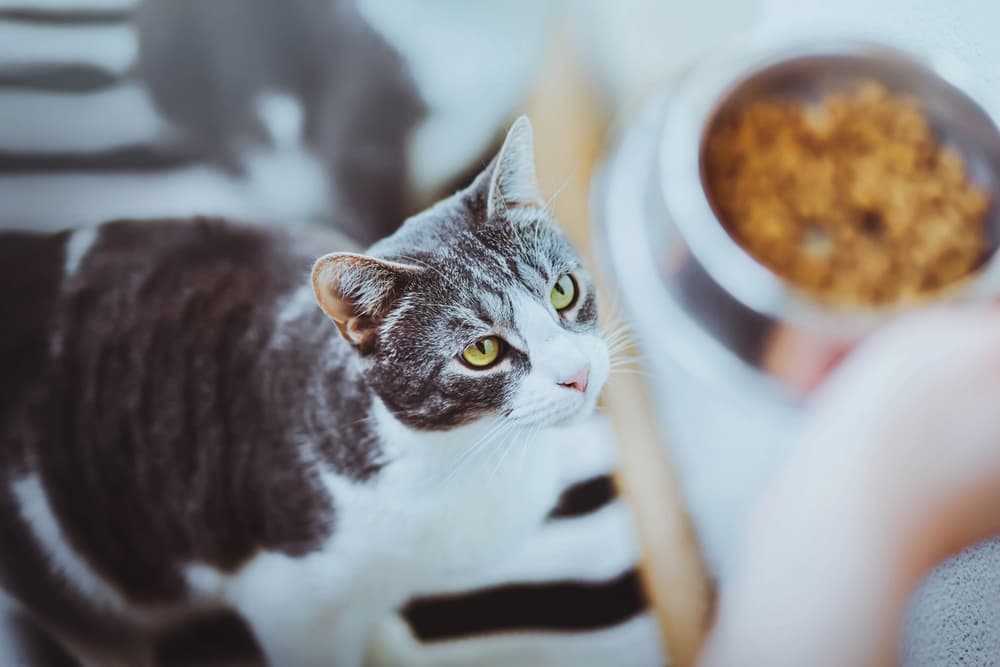How Heavy Should My Cat Be? A Healthy Weight Guide

Pet obesity is one of the leading health threats to pets in the United States and other developed countries. It is also the most easily preventable. However, overweight cats are now more common than lean cats, making it harder for cat parents to recognize when their pet is packing on extra pounds. While chunky cats are quite adorable, obesity is not a harmless condition. Obese cats are much more likely to develop serious diseases and have a decreased life expectancy than their lean counterparts.
So how can you determine if your cat is overweight? Or perhaps you are worried your cat is actually too thin? If you’ve ever asked yourself how heavy should my cat be, read on to learn how to identify a healthy weight for your feline companion so you can better manage their overall health and longevity.
Average Cat Weight: What the Scales Say

The average domestic cat should weigh roughly 10 pounds or 4.5 kilograms, although this can vary greatly. Factors such as breed, sex, spay/neuter status, and age can all affect a cat’s ideal weight range. For example, a male Maine Coone can be 25 pounds and considered ideal, while a female Persian cat can weigh 8 pounds at a healthy weight. Many cats are mixed breeds these days, which can make it even harder to determine an ideal range for “all cats.”
Another issue with using the “average” cat weight to help you determine if your individual cat is within their ideal range is the fact that more than 60 percent of cats in the United States are now overweight or obese. This skews the average toward a heavier number than is actually ideal for most cats.
We make it easy to track your pet’s weight using our FREE weight tracker. Sign up today!
How Heavy Should My Cat Be?

Cats, like humans, are individually unique and special. Therefore, there is no “one size fits all” weight recommendation. Instead, owners and veterinarians can rely on specific indicators to determine whether or not a cat is over or under their ideal weight.
The best way to determine if your pet is at a healthy cat weight is to ask your veterinarian. While your veterinarian will weigh your cat, they will also evaluate their frame size and lean muscle mass to determine a healthy weight for your cat. Most veterinarians are trained using the Body Condition Scoring method, which you can also learn to use yourself to help manage your cat’s weight.
Body Condition Scoring is the act of physically and visually assessing an animal to determine their Body Condition Score (BCS). BCS is measured on a scale of 1-9, with 1 being very thin and 9 being severely obese. A BCS of 4-5 is considered ideal.
The three main places used to determine a cat’s BCS are their ribs, waist, and lower abdomen. An ideal cat with a BCS of 4-5 will have a distinct waist where their ribs end and their abdomen begins, and it should be visible from their topline and profile. You should be able to easily count their ribs by gently applying pressure with your fingers and they have minimal abdominal fat under their belly.
Underweight cats with a BCS of 3 or less will have visible ribs and vertebrae that can be counted without touching, a very sharp waist, and no abdominal fat.
Obese or overweight cats with a BCS of 6 or more will have a belly that hangs down when viewed from the side, their abdomen will often be wider than their ribcage when viewed from the topline or profile, and you will not be able to count their ribs using gentle pressure with your fingers.
Above is an easy-to-follow cat weight chart that all cat parents can print out and hang up next to their pet’s food container for reference. It can be used as a daily reminder of what your cat should look like, so you can more easily notice if they have strayed out of a normal body condition score and take steps sooner to correct the issue.
Why Maintaining a Healthy Cat Weight is Important

As mentioned, feline obesity is not a benign disease, meaning that it isn’t wise to turn a blind eye to your cat’s pudgy waistline. Cats carrying around extra body weight have extra stress and strain on their body. Overweight or obese cats are more likely to develop serious health conditions such as diabetes mellitus, painful arthritis, high blood pressure, pancreatitis, kidney disease, and more. Cats suffering from obesity do not live as long as their lean companions.
On the flip side, it is also important to ensure that your cat is not underweight. Unintentional weight loss in cats can be a sign of serious health conditions such as hyperthyroidism, kidney disease, or diabetes mellitus.
By maintaining a healthy cat weight, you increase their chances of living a longer, more comfortable life.
Obesity complications in felines can reduce a cat’s lifespan by an average of two years. Therefore, weight management is important for cats of all ages, especially older cats. Obesity in cats has been linked to various types of cancer, diabetes mellitus, and urinary disorders. Furthermore, carrying around excessive weight can worsen osteoarthritis, heart disease, and respiratory disorders in cats.
Maintaining a healthy weight for your senior kitty is imperative. Gentle exercise that’s easy on the joints (and without excessive jumping or sharp turns) is ideal for senior kitties; using a feather toy or wand can be inviting. On the other hand, sudden or gradual weight loss that has been non-purposeful can indicate an underlying health condition in a senior cat. Therefore, speak with your veterinarian if your once plump older feline is suddenly looking a lot more frail than previously.
How to Help a Cat Lose Weight or Gain Weight

The easiest way to treat excess weight in cats is to avoid it to begin with. It is much harder to lose weight than it is to simply take proactive steps to maintain a healthy cat weight, which are outlined in the next section.
If you notice that your cat is looking more round than they should or used to, or if your veterinarian recommended that your cat lose weight, here are some easy weight loss tips for cats:
- Switch to a weight management cat food
- Measure out portioned meals to ensure your cat is not taking in excess calories
- Make sure to limit treats and only offer low calorie treats throughout the day
- Separate cats on a diet from their housemates during mealtimes to prevent them from stealing extra food
- Encourage your cat to exercise by feeding them with food puzzles, playing with them for 10 minutes at least three times daily, having them chase a laser pointer, or purchasing interactive toys
- Consider forage feeding to increase both mental and physical stimulation.
If you suspect your cat is underweight or if you’ve noticed your cat is losing weight, it’s highly recommended that you first schedule a veterinary visit to rule out serious medical causes of weight loss. Even if you have taken in a stray that is underweight but otherwise seems healthy, they could need medical intervention for internal or external parasites that are leaching critical nutrients from them.
Once your veterinarian has ruled out medical causes of cat weight loss, helping your cat gain weight is simple. Start by increasing portion sizes of meals or consider switching to a higher calorie cat food. While it’s tempting to spoil a skinny cat with treats, do not go overboard. Treats lack essential nutrients and can result in your cat putting on more fat than muscle, instead of a steady amount of both. Once your cat has reached an ideal weight, transition them to a weight management diet to prevent them from gaining too much.
How to Maintain a Healthy Cat Weight

Maintaining a healthy weight for cats starts with the basics. Rather than “free feeding” your cat or cats by leaving food out all day, measure out their meals so you can control their calorie intake. Make sure you are feeding a quality, complete and balanced diet so they aren’t missing any essential nutrients, and ensure they have access to fresh, clean drinking water all day.
Weighing your cat regularly is another key in maintaining a healthy weight. Baby scales work well for this, or you can simply weigh yourself with and without your cat and then subtract the difference. By checking your cat’s weight regularly, you’ll be able to notice changes in weight before you can visibly see them. It’s a good idea to weigh cats at least once a month if not more.
Most importantly, do not underestimate the importance of exercise for cats. Encourage cats to chase toys or climb, and consider leash and harness training them so they can get those steps in. Building lean muscle mass will not only help boost your cat’s metabolism, but it helps cushion and protect their joints.









